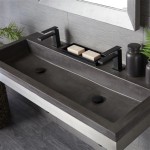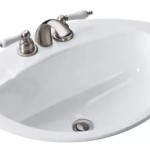Small Bathroom Sink: Maximizing Space and Style
The small bathroom presents a unique design challenge. While space is limited, functionality and aesthetics remain crucial. Selecting the right sink is paramount in achieving both. A small bathroom sink, designed to conserve space without compromising on usability, is a cornerstone of successful small bathroom design.
Choosing a sink for a compact bathroom requires careful consideration of several factors. Size, style, mounting options, and material all play a significant role in the overall look and feel of the room. Understanding the various options available is essential for making an informed decision that aligns with the bathroom's dimensions and the user's personal preferences.
This article explores the various aspects of small bathroom sinks, providing a comprehensive overview of the types available, the considerations involved in their selection, and tips for maximizing space and style in a small bathroom setting. From identifying space-saving designs to understanding material properties, this guide aims to equip the reader with the knowledge necessary to choose the perfect small bathroom sink.
Understanding Different Types of Small Bathroom Sinks
Small bathroom sinks come in a variety of styles, each offering a unique blend of aesthetics and functionality. The choice of sink type can significantly impact the room's layout and overall design. Common types of small bathroom sinks include wall-mounted sinks, corner sinks, pedestal sinks, vanity sinks, and vessel sinks.
Wall-mounted sinks are a popular choice for small bathrooms due to their space-saving design. These sinks are directly attached to the wall, leaving the floor space underneath open. This creates an illusion of more space and allows for easy cleaning. Wall-mounted sinks come in various shapes and sizes, from compact rectangular designs to sleek, modern curves. One key advantage is the ability to customize the height of the sink during installation, accommodating users of different heights.
However, wall-mounted sinks also have limitations. The plumbing is typically exposed, which may require additional work to conceal for aesthetic purposes. Furthermore, wall-mounted sinks do not offer any built-in storage, requiring alternative solutions for storing toiletries and other bathroom essentials. The wall must also be structurally sound to support the weight of the sink, especially when filled with water.
Corner sinks are specifically designed to fit into the corner of a room, making them an ideal solution for very small or oddly shaped bathrooms. These sinks maximize the use of space in often-overlooked areas. Corner sinks are available in various styles, ranging from traditional to contemporary. The plumbing is usually partially concealed, and some models offer a small shelf or ledge for storing a few items.
The downside of corner sinks is that they may not provide ample counter space. The triangular shape can also make it challenging to find complementary accessories and storage solutions. While they are efficient in utilizing corner space, they might not be the most comfortable option for frequent use due to their limited size.
Pedestal sinks consist of a sink basin supported by a single, freestanding pedestal. They offer a classic and elegant look and are often favored for their simplicity and relatively small footprint. Pedestal sinks are available in a wide range of styles, from traditional Victorian designs to modern minimalist options. They can be a good choice for bathrooms with limited space where a more traditional aesthetic is desired.
Similar to wall-mounted sinks, pedestal sinks do not provide any built-in storage. Concealing the plumbing can also be a challenge, although some pedestal sinks are designed with a shroud or covering to partially hide the pipes. Pedestal sinks can be susceptible to tipping if not properly installed and secured to the wall.
Vanity sinks are integrated into a cabinet or countertop, providing both a sink and storage space. These are particularly useful in small bathrooms where storage is at a premium. Vanity sinks come in a wide range of sizes, styles, and materials. Floating vanities, which are mounted to the wall and leave the floor space underneath open, are a popular choice for small bathrooms as they create an illusion of more space.
The key advantage of vanity sinks is the ample storage they provide. They offer a place to store toiletries, towels, and other bathroom essentials, helping to keep the room organized and clutter-free. However, vanity sinks take up more floor space than wall-mounted or pedestal sinks. Careful consideration of the vanity's dimensions is essential to ensure it fits comfortably in the bathroom without overcrowding the space. A smaller depth vanity can be a good option for narrow bathrooms.
Vessel sinks, also known as bowl sinks, sit on top of a countertop or vanity. They offer a unique and contemporary look and can add a touch of elegance to a small bathroom. Vessel sinks come in various shapes, sizes, and materials, from glass and ceramic to metal and stone. The height of the countertop must be carefully considered to ensure the overall height of the sink is comfortable for use.
While vessel sinks can be visually appealing, they can also present some challenges. They typically require a taller faucet to accommodate the height of the sink. Cleaning around the base of the vessel sink can also be more difficult than with other types of sinks. The countertop space around the vessel sink is reduced, which may be a concern in very small bathrooms.
Key Considerations When Choosing a Small Bathroom Sink
Selecting the right small bathroom sink involves more than just choosing a style that appeals to the eye. There are several practical considerations that must be taken into account to ensure the sink is both functional and aesthetically pleasing within the limited space of a small bathroom. These include size and dimensions, material, style and aesthetics, plumbing considerations, and budget.
Size and Dimensions: The most crucial factor in selecting a small bathroom sink is its size. Accurate measurements of the available space are essential. Consider the width, depth, and height of the sink to ensure it fits comfortably without overcrowding the bathroom. A small sink that is too bulky can make the room feel cramped and uncomfortable. Be sure to map out the space with painter's tape to get a feel for the actual footprint of the sink.
For very small bathrooms, consider sinks with a depth of less than 18 inches. Wall-mounted and corner sinks are often the best options for maximizing space in these situations. If opting for a vanity sink, look for models with a shallow depth and clever storage solutions to make the most of the available space. It's also important to consider the placement of the sink relative to other fixtures, such as the toilet and shower, to ensure adequate clearance and ease of movement.
Material: The material of the sink affects its durability, maintenance requirements, and overall aesthetic. Common materials for small bathroom sinks include ceramic, porcelain, glass, stainless steel, and stone. Each material has its own advantages and disadvantages.
Ceramic and porcelain are popular choices due to their durability, affordability, and ease of cleaning. They are resistant to stains and scratches and come in a wide range of colors and styles. Glass sinks offer a unique and modern look but can be more susceptible to chips and scratches. Stainless steel sinks are durable and hygienic but may show water spots and fingerprints more easily. Stone sinks, such as granite or marble, offer a luxurious and natural look but require more maintenance and can be more expensive.
Style and Aesthetics: The style of the sink should complement the overall design aesthetic of the bathroom. Whether the bathroom is modern, traditional, or minimalist, the sink should be chosen to enhance the existing decor. Consider the shape, color, and finish of the sink to ensure it blends seamlessly with the other fixtures and accessories in the room.
For modern bathrooms, sleek and minimalist sinks with clean lines are a good choice. Wall-mounted or vessel sinks in glass or stainless steel can create a contemporary look. For traditional bathrooms, pedestal sinks with decorative detailing or vanity sinks with ornate hardware can add a touch of elegance. In small spaces, it's often best to opt for lighter colors to create a brighter and more open feel.
Plumbing Considerations: Before purchasing a small bathroom sink, it's important to consider the existing plumbing in the bathroom. The location of the water supply lines and drainpipe will influence the type of sink that can be installed. If replacing an existing sink, ensure the new sink is compatible with the existing plumbing configuration or be prepared to make necessary adjustments.
For wall-mounted sinks, the plumbing will need to be accessible within the wall. For vanity sinks, ensure there is adequate space for the drainpipe and water supply lines within the cabinet. If the plumbing needs to be rerouted, it's best to consult with a qualified plumber to ensure the work is done safely and correctly.
Budget: The cost of a small bathroom sink can vary widely depending on the material, style, and brand. It's important to set a budget before starting the search and stick to it. While it's tempting to opt for the cheapest option, it's important to consider the long-term value and durability of the sink. Investing in a higher-quality sink may save money in the long run by reducing the need for repairs or replacements.
In addition to the cost of the sink itself, factor in the cost of installation, plumbing, and any necessary accessories, such as faucets and drain assemblies. Getting quotes from multiple plumbers and contractors can help ensure you are getting a fair price for the installation work.
Maximizing Space and Style with Your Small Bathroom Sink
Once the right small bathroom sink has been selected, the next step is to maximize its functionality and aesthetic appeal within the limited space. This involves strategic placement, clever storage solutions, and careful selection of accessories. By paying attention to these details, it is possible to create a small bathroom that is both functional and stylish.
Strategic Placement: The placement of the sink is crucial in maximizing space and functionality. Consider the flow of traffic within the bathroom and position the sink in a location that does not impede movement. Avoid placing the sink too close to the toilet or shower, as this can make the space feel cramped and uncomfortable.
If possible, position the sink near a window to take advantage of natural light. Natural light can make a small bathroom feel brighter and more open. If natural light is limited, consider adding additional lighting fixtures around the sink to improve visibility and create a more welcoming atmosphere. Sconces or a vanity light above the mirror can provide ample illumination for tasks such as shaving and applying makeup.
Clever Storage Solutions: Storage is at a premium in small bathrooms, so it's important to maximize every inch of available space. Vanity sinks with built-in storage are an excellent option for storing toiletries, towels, and other bathroom essentials. If a vanity sink is not feasible, consider adding wall-mounted shelves or cabinets above or beside the sink to provide additional storage.
Utilize vertical space by installing tall, narrow shelves or cabinets. Over-the-toilet storage units can also provide additional storage without taking up valuable floor space. Consider using baskets or bins to organize items within shelves and cabinets, making it easier to find what you need.
Careful Selection of Accessories: The accessories in a small bathroom can have a big impact on its overall look and feel. Choose accessories that are both functional and aesthetically pleasing. Opt for smaller-scale accessories that won't overwhelm the space. Consider using a frameless mirror to create an illusion of more space. A large mirror can also reflect light and make the bathroom feel brighter.
Choose coordinating faucets, towel bars, and soap dispensers that complement the style of the sink and the overall design of the bathroom. Avoid cluttering the countertop with unnecessary items. Keep only the essentials on the countertop and store the rest in drawers or cabinets. A clean and uncluttered countertop will make the bathroom feel more spacious and organized.
Lighting: Proper lighting is essential in any bathroom, but it's especially important in small bathrooms. Good lighting can make a small space feel larger and more inviting. Consider using a combination of ambient, task, and accent lighting to create a well-lit and visually appealing space. Recessed lighting can provide ambient lighting without taking up valuable space. Task lighting, such as vanity lights, can provide direct illumination for tasks such as shaving and applying makeup. Accent lighting, such as under-cabinet lighting, can add a touch of drama and highlight architectural features.

Sinks For Small Bathrooms Guide Lowe S

8 Small Bathroom Sinks That Will Make A Big Impact Architectural Digest

Scarabeo 1501 By Nameek S Soft Small Ceramic Wall Mounted Or Vessel Sink Thebath

14 Splendid Small Bathroom Sink Ideas Shelfgenie

Nameeks Mini Wall Mounted Bathroom Sink In White Cerastyle 001400 U One Hole The Home Depot

Vanities For Small Bathrooms

Vc Cucine 18 W X 10 D 36 H Small Bathroom Vanity In Danube Oak With White Ceramic Single Sink Us15 Dnh 042 The Home Depot

Acf C140 By Nameek S Cubical Small Bathroom Vanity Floating 19 Larch Canapa Thebath

Bathroom Sink Ideas For Small Spaces Hunker

Small Basin
Related Posts







